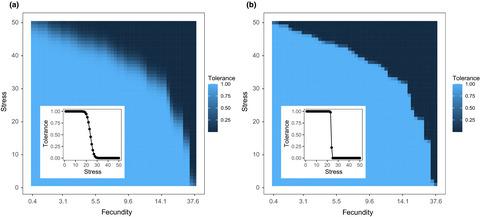Our official English website, www.x-mol.net, welcomes your feedback! (Note: you will need to create a separate account there.)
Competition for space in a structured landscape: The effect of seed limitation on coexistence under a tolerance‐fecundity trade‐off
Journal of Ecology ( IF 5.5 ) Pub Date : 2021-02-06 , DOI: 10.1111/1365-2745.13613 Rafael D’Andrea 1, 2 , James P. O’Dwyer 3
中文翻译:

结构化景观中的空间竞争:在公差-丰度折衷下种子限制对共存的影响
更新日期:2021-04-08
Journal of Ecology ( IF 5.5 ) Pub Date : 2021-02-06 , DOI: 10.1111/1365-2745.13613 Rafael D’Andrea 1, 2 , James P. O’Dwyer 3
Affiliation

|
- Life‐history trade‐offs are important coexistence mechanisms in plant communities. In particular, a trade‐off between seed quality and seed output may explain coexistence among species with a wide variety of seed sizes in heterogeneous landscapes with varying degrees of local stresses such as shade, drought and browsing.
- Under spatially implicit formulations of the tolerance‐fecundity trade‐off, species diversity is only bounded by community size and environmental heterogeneity. However, these formulations leave unanswered the question of how dispersal limitation, an important aspect of real communities, impacts the ability of the tolerance‐fecundity trade‐off to support coexistence.
- Here we show using stochastic cellular automata that coexistence under the tolerance‐fecundity trade‐off in a spatially structured landscape is strongly modulated by the interactions between the spatial scales of species dispersal and environmental variability. Specifically, coexistence in a patchy landscape is higher under short dispersal scales relative to the scale of environmental variation. These conditions allow species to segregate spatially and thus avoid interspecific competition.
- In addition to dispersal limitation, coexistence under the tolerance‐fecundity trade‐off is promoted by a sharp drop in tolerance as local environmental stress increases, a high overall seed output across species, local homogeneity in environmental conditions and weak age structure in fertility. In particular, coexistence is much higher when species have full tolerance to stress levels below a threshold and zero tolerance above that threshold, with nothing in between. This steep gradient contributes to coexistence because it maximizes niche separation between similar species.
- Synthesis. When plants compete for space, dispersal limitation and landscape spatial structure can conspire to boost coexistence and diversity. Our results show that the tolerance‐fecundity trade‐off is a strong niche differentiation mechanism when species experience a well‐defined distinction between suitable and unsuitable environments, and supports higher diversity when dispersal scales are shorter than the scales of variation in the environment. We conclude that the trade‐off is more likely to be a relevant coexistence mechanism in the context of large‐scale environmental variation, such as topography, than small‐scale variation, such as in litter cover and canopy shading.
中文翻译:

结构化景观中的空间竞争:在公差-丰度折衷下种子限制对共存的影响
- 生命历史权衡是植物群落中重要的共存机制。特别是,种子质量与种子产量之间的权衡可能解释了在具有不同程度的局部胁迫(例如阴影,干旱和浏览)的异质景观中,具有多种种子大小的物种之间的共存。
- 在容忍-功能折衷的空间隐式表述下,物种多样性仅受社区规模和环境异质性的限制。但是,这些表述还没有解决以下问题:分散限制是现实社区的一个重要方面,它如何影响容忍度—权衡取舍的能力以支持共存。
- 在这里,我们展示了使用随机细胞自动机,物种分布的空间尺度与环境可变性之间的相互作用强烈地调节了空间结构景观中的容忍-丰度折衷下的共存。具体而言,相对于环境变化的规模,在短的分散尺度下,斑驳景观中的共存性更高。这些条件允许物种在空间上隔离,从而避免种间竞争。
- 除了扩散限制外,随着局部环境压力的增加,耐受性的急剧下降,跨物种的总体种子产量高,环境条件下的局部同质性以及育性的年龄结构薄弱,在耐受性-生殖力权衡的情况下共存也得到了促进。特别是,当物种对低于阈值的压力水平具有完全的承受能力,而对于该阈值以上的零承受能力具有完全的容忍度,而两者之间没有任何容忍度时,则共存性要高得多。这种陡峭的梯度有助于共存,因为它使相似物种之间的生态位分离最大化。
- 综合。当植物争夺空间时,扩散限制和景观空间结构可以共同促进共存和多样性。我们的结果表明,当物种在合适和不适合的环境之间进行明确定义的区分时,宽容-丰度折衷是一种强大的利基分化机制,当分散规模小于环境变化规模时,则可以支持更高的多样性。我们得出的结论是,在大范围环境变化(如地形)的背景下,折衷更可能是相关的共存机制,而不是小规模变化(如垫料覆盖和冠层遮荫)下的相关共存机制。



























 京公网安备 11010802027423号
京公网安备 11010802027423号